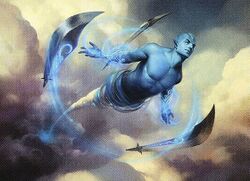Djinn
| Djinn | |
|---|---|
| Creature Type | |
| (Subtype for creature/kindred cards) | |
| Introduced | Arabian Nights |
| Last used | Tarkir: Dragonstorm |
| Beeble Scale | 4[1] |
| Scryfall Statistics | |
Djinn is a creature type used for cards that depict certain spirits of air or fire, commonly forced into slavery by mortal beings to utilize their immense magical powers, usually in the form of a "wish;" as well as the infernal spirits with a fiery appearance known as "efreets."
Description
Although some djinn will grant wishes, sorcerers or sahirs usually bind djinn to have them in servitude for a longer time, not just until their wishes are granted. A djinn must be bound to a magical object such as a ring, lamp, cauldron, or bottle, and must be weaker than its master.[note 1] A djinn will seize any opportunity to attack the Sahir if it senses that it has an advantage. Also, some djinn are so powerful that they can break free after a certain number of days in slavery. They are highly intelligent and will remember the masters that treated them kindly and those that did otherwise. Many djinn smell vaguely of smoke.[2]
Note that Efreets used to be considered separate creature types in Magic, while they in historical sources sometimes are considered a subclass of djinns. The first djinns and Efreeti were featured in the Arabian Nights set.[3] While they were printed over all colors except white with a lean towards blue, after Judgment all new Djinns were blue-aligned (barring the zombie Silumgar Butcher and the Mirage call-back red Emberwilde Captain). Beginning with Modern Horizons 3, Efreet was retired as a creature type and combined with Djinn.
Djinn replaced sphinxes as blue's iconic species on Dominaria.[4] They also appeared in Khans of Tarkir block as the resident blue race of the Jeskai Way, again replacing Sphinxes.
Storyline
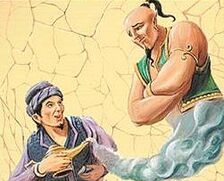
Arcavios
The Djinn of Arcavios are blue-skinned, slim, and with pointy ears. They don't need to sleep. Those who go to Strixhaven are affiliated with Prismari.
Dominaria
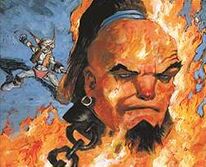
The Djinn of Dominaria are fickle tricksters whom foolhardy mortals seek to imprison and bind to their will.[5]
Benthic djinns
An exceedingly rare example of a djinn who dwells in the deep waters of Dominaria near the merfolk kingdom of Etlan Shiis.
Coalition djinns
At the time of the phyrexian Invasion, several djinns joined the fight on the side of the coalition: Ruham Djinn, Zanam Djinn, Goham Djinn, Halam Djinn, Sulam Djinn.
Kookus
Kookus is a type of djinn from the Jamuraan mountains. The local goblins have taken the job unto themselves of containing them. These goblins are also responsible for their very goblin-ish name, which is pronounced Cook-Us.
Mahamoti Djinns
The Mahamoti djinns are the most regal of all air spirits, considering themselves to be royalty among djinns.[6] The Mahamoti devote all their magical power toward making themselves as grandiose as possible, both in terms of size and manner. They love confusing those around them with intimidation, wordplay, and misdirection. They can often be found in gambling halls, where they use their power and quick wits to increase their stature and wealth at the expense of others. The Mahamoti don't try to trick or hurt the mages who summon them, largely because to do so would be to admit that someone else has power over them. Once captured, they will brood, but they will serve quietly and without complaint, secure in the knowledge that everything else is literally beneath them.
Marid
The first to arrive on Dominaria from Rabiah.[7]
Gobakhan
On Gobakhan small fire djinns or air djinns sometimes emerge from the Western Cloud or the Eastern Cloud respectively. If a djinn is caught, for example within geometry, it has to grant a wish for its release.[2]
Ravnica
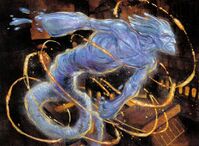
Pure Ravnican Djinns are tremendously powerful and in fact deemed too dangerous to exist according to the Guildpact.[8] Around the time of the Decamillennial the few pure Ravnican Djinn still alive have become forced laborers in the polar regions. Human/djinn hybrids with far lesser powers are employed by the Izzet.
Tarkir

Djinn and efreet are commonplace on Tarkir, participating in civic life alongside other humanoids.[9] In Tarkir's original timeline, they mostly adhered to the Jeskai Way. In the new timeline, Jeskai lands were conquered by the dragonlord Ojutai and his brood, and many djinn submitted to his teachings of dragon worship. However, after the Stormnexus Ritual and the fall of the dragonlords, the people of Tarkir became free to live where they chose, and many left the Way for other clans. One example is the djinn Nur, an emissary of the Abzan Houses.
Tarkiri djinn are corporeal beings, as evidenced by the fact that they can be turned into zombies after they die.[10] They have white skin, no hair, and short, curved horns which can grow in various shapes. All djinn have one pair of horns which grow from the sides of their skull, but male djinn always have two additional pairs which grow from their jaw, while some female djinn have a second pair that grows out from the back of their skull.[11]
Wildfire
The Emberwilde Djinns are ruled by the Emberwilde Caliph and are themselves the rulers of the fire-based plane of Wildfire. They also have much influence on and in the Jamuraan nation of Suq'Ata, since there are natural portals between the two of them.

|
Ambiguous “To be honest, I’m not quite sure what’s going to happen.”
|
Rabiah

Six types of djinns live on the plane of Rabiah: True Djinn, Djann, Efreet, Nekrataal, Marid, and Ghoul. Since Djinn is both the name for all six of them and the name of one specific group, the term "Djinn Tribes" is used when talking about the six of them together, and "True Djinn" for the sub-group, to avoid confusion. Most of the djinn tribes are only native to Rabiah, but they often cross over to planes that have steady portals to Rabiah, such as Wildfire and Dominaria. All members of the djinn tribes can shapeshift and most of them can fly.[12]
Originally, the djinn were a race of nature, unbound to either good or evil. But when unknown forces made them choose between either light or darkness, the stage was set for a holy war between the rivaling djinn tribes.[note 2]
Most of the True Djinn decided to remain neutral, although some of them did join either the side of good or evil. Completely converted was the Djann tribe, which followed the path of truth. Of the four remaining tribes, three declared war on the light. First and foremost was the order of the Efreet, ancient arch-enemies of the Djann and inherently evil. The Efreeti led the other two tribes: the Nekrataal and the Ghoul. The Marids, the oldest, most powerful, and most individual tribe, were allowed to choose their path as they saw fit. Many turned to the aid of the Djann.
When the djinn tribes of light sought to better their position, the others reacted violently. The leader of the efreets, the demonic Iblis, sought to wipe out the converted djinn. He led an army against the djann and their human allies. The marids, however, intervened and the efreets were forced away. As a result of this conflict, the efreet are less powerful these days than they once were, and the marid became rare and secluded.

With the power of the djinn fading away gradually due to the constant infighting, King Suleiman seized the opportunity to bind the spirits of Rabiah to his command. As he rose to power he used a serpent staff, a cauldron, and a ring to capture seventy djinn, although legend holds it they defied him at every possible chance. The most powerful of his enslaved djinn was the True Djinn Shamir, who took the form of a meager worm.
Suleiman even managed to pass on his powers of binding to future generations by creating a magical pentagram that ensured that no djinn or efreet of Rabiah would fail to recognize his name and authority. There are many djinn who seek the blood of King Suleiman’s followers, for his reign over ancient Rabiah, led to the enslavement of seventy djinn, and Suleiman was no kind master.
True djinns
The true djinns are the largest of the djinn tribes. The djinns are closely related to the efreets. Several True Djinn have joined the two sides of the Spirit War, but most of them remain neutral. Many neutral djinn are still feral though, attacking anything in sight, which makes most people think they are evil nonetheless.
Due to their overwhelming numbers, the True Djinn are the most influential of their kind and control much of Rabiah and all of Wildfire. The majority of djinn are aligned with blue, draw their power off gold, and are vulnerable to copper and agate. Like all other Djinn, they are capable of shapeshifting, but not with as much speed or treachery as the efreeti. They often live in windy and aerial regions, and many can fly either with natural or magical means. Below are the different tribes descended from Rabiah Djinn.
Aku djinns
The Aku Djinns were fierce and flesh-hungry but used by the people of Zhalfir as protectors of the city-tomb Aku. Although the flavor text of the card could be interpreted otherwise; the Aku Djinn never joined Kaervek and were instrumental to his defeat.
Erhnam djinns
The Erhnam Djinns are typically found prowling in forested areas, hunting lesser beings for amusement.[13] Their love of the hunt is so great that they often use their magic to make their prey better able to flee through the forests and therefore provide more of a challenge for the djinn. Their fondness for doing this often causes problems for a mage controlling an Erhnam Djinn, as the creatures it has empowered can use their newfound skills to attack the djinn's master. This often provides extra amusement for the djinn, who find entertainment in the suffering of people claiming to be their superior. A few Erhnam Djinns somehow made it to Otaria.
Juzám djinns
The Juzám Djinns are some of the most powerful djinn in Rabiah, second only to the Serendib Djinn. They can only be subdued with great difficulty and often rebel against their masters, inflicting great damage on the Sahir that attempts to control them.
Serendib djinns
The Serendib Djinns are the most powerful of the Rabian djinn. They are immensely strong and are closely related to the Serendib Efreets, but also cursed and exceedingly difficult to control. Although their most imposing quality is their strength as heavy elementals of air, the Serendib Djinn are also extremely intelligent and can grant wishes.
Efreets
The efreets are the second most common and the most dangerous of the djinn tribes.
Djann
The benevolent djann are not necessarily constant friends of mankind, but they embrace light more than any other djinn. Djann are the eternal enemies of the efreets, nekrataals, and ghouls, and traditionally have defended those they find pure. Since they often visit desert oases, they were the first to come into contact with humans.
Caravan traders respect these powerful spirits, who can hide or reveal oases to those they deem worthy or unworthy. Djann often appear as white camels or soldiers, disappearing occasionally into sand cyclones. They tend to stay out of cities and roam the deserts, which brings them into conflict with the other desert-dwelling tribe, the ghoul.
Ghoul

Also known as Ghul, the ghouls are the lowest order of djinn. They live in deserts, wastes, and shadowy areas of Rabian cities. They draw power off the dead.
Despite being very intelligent, they are driven by instincts and act like wild animals when seeking food. Ghouls are highly superstitious and consider hospitality very important. Those ghouls who offered salt will refuse to harm the giver and his household. Ghouls disguise themselves regularly as pilgrims or travelers and attack their hosts if not shown the proper hospitality.
Ghouls prey upon individuals and small groups, attacking them openly. Fights between ghouls are common over the victim, and they will also seek out graves and eat the corpses when no other food presents itself. Powerful ghouls can shapeshift into vultures and follow lower ghouls to battlefields and dying travelers. Because they prey on those who cross the great sands of Rabiah, the ghouls are arch-enemies of the djann. Sahirs seeking to control ghouls will use Cat’s Eye talismans; however, the far more common approach against ghouls is for travelers of the Rabian deserts to bring iron with them.
Many creatures with ghoul in their name or even in their creature type have been printed, but only Khabál Ghoul is a ghoul of the djinn tribes. In the Arabian Nights expansion Wizards of the Coast used the term "Ghoul" like it is used in Arabian tradition, but after that set, they have been using "Ghoul" like it is used in the western tradition. While in Arabian tradition a ghoul is indeed a wandering spirit, in the West the term is largely synonymous with Zombie.
Marid
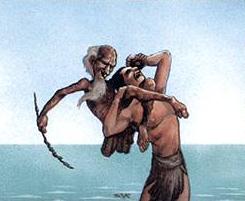
The marids are the oldest tribe of djinn and the most respected. Although they are isolated and few, these spirits are the most powerful of the djinn tribes. There is a legend that one of the marid was the first djinn of Rabiah and that all others came from him.
Masters of weather, wind, and water, the marids tend to live near the coast and travel in great waterspouts. Most of the marids have left the mortal plane, choosing to abstain from the holy war between the rival djinn tribes. Those that have remained draw their earthly power from water. Marids often appear as old men, porpoises, or horses, leading travelers to wise courses.
Copper, iron, and jade are all talismans used against marids. In the Grand Creature Type Update the subtype Marid (Old Man of the Sea) was changed to Djinn.
Notable djinns
Tokens
| Token name | Color | Type line | P/T | Text box | Source | Printings |
|---|---|---|---|---|---|---|
| Djinn | Artifact Creature — Djinn | 5/5 | Flying | |||
| Djinn Monk | Creature — Djinn Monk | 2/2 | Flying |
Trivia
- A cycle of punny Djinns was designed for Unglued 2 [14][15]
- The creature type Marid (an old Arabian word meaning 'rebel' or 'evil spirit'[16]) was incorporated in the Djinn type during the Grand Creature Type Update.
- As part of the world evolution of Tarkir, the Abzan-aligned Severance Priest is the first Djinn to be green since the Invasion cycle of Djinn. It would also be the second non-red, non-blue Djinn since then, after the zombified Silumgar Butcher, also of Tarkir.
Notes
- ↑ Presumably this means the djinn would have to have less willpower than their master, for a djinn who is magically or physically weaker than the Sahir is likely of little use.
- ↑ This war was originally called the Jihad, but since Arabian Nights came out that term has become far more loaded than it was, and is now commonly referred to as the Spirit War.
References
- ↑ Mark Rosewater (2012-12-01). "Will we ever see Djinn come back as blue's fat flyers...". Blogatog. Tumblr.
- ↑ a b Greg Weisman (November 2019). "War of the Spark: Forsaken". Del Rey.
- ↑ Magic Arcana (July 10, 2002). "Suleiman and the genies". magicthegathering.com. Wizards of the Coast. Archived from the original on 2021-04-18.
- ↑ Magic Story Podcast, Dominaria Part 1
- ↑ Wizards of the Coast (April 22, 2018). "Tricksters, rogues, and forbidden magic!". The Official Magic: The Gathering Tumblr. Tumblr.
- ↑ Mahamoti Djinn (archived). wizards.com.
- ↑ Flavor text for Tempest Djinn
- ↑ Cory J. Herndon. (2006.) Ravnica Cycle, Book II: Guildpact, Wizards of the Coast.
- ↑ Jeskai Ascendancy, Ojutai's Command, Will of the Jeskai
- ↑ Silumgar Butcher
- ↑ Sage-Eye Avengers
- ↑ MTG Continuity by Jeff Lee
- ↑ Erhnam Djinn (archived). wizards.com.
- ↑ Magic Arcana (August 08, 2005). "Punny Djinns". magicthegathering.com. Wizards of the Coast. Archived from the original on 2020-09-22.
- ↑ Punny Djinns. Mtgpics.com.
- ↑ Wizards of the Coast (April 2005). "Ask Wizards - April 2005". magicthegathering.com. Wizards of the Coast. Archived from the original on 2021-04-29.
